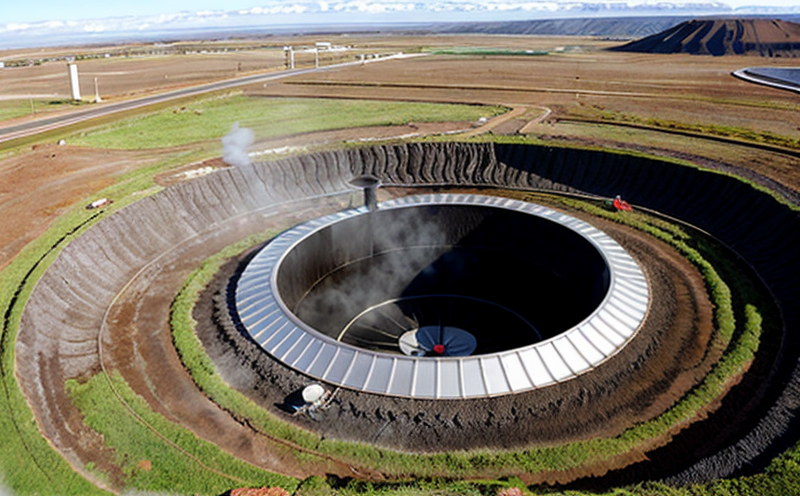ASTM E164 Ultrasonic Testing of Geothermal Plant Welds
The ASTM E164 standard is widely recognized as a reliable method for inspecting welds in geothermal plant structures. This ultrasonic testing ensures the integrity and reliability of critical components, which are essential to prevent leaks or failures that could compromise safety and efficiency.
Geothermal energy systems involve high-temperature and -pressure environments. Welds within these systems must withstand extreme conditions, making their inspection a crucial step in quality assurance. ASTM E164 ultrasonic testing provides non-destructive evaluation (NDE) of the welds' structural integrity by measuring sound wave reflections from defects.
The testing process involves placing a transducer on either side of the weld to generate and receive ultrasonic waves. These waves penetrate through the metal, reflecting back when they encounter changes in density or geometry due to flaws within the material. The reflected signals are then analyzed for their amplitude and time-of-flight to determine defect presence and extent.
Before testing, proper specimen preparation is vital. This includes cleaning the weld area of dirt, oxides, and other contaminants, ensuring it is free from any foreign materials that could affect test results. Specimens must also be inspected visually for surface irregularities such as cracks or inclusions before undergoing ultrasonic evaluation.
The testing setup typically consists of a high-frequency probe connected to an instrument capable of generating and receiving ultrasonic signals. The probe transmits sound waves into the metal structure, which then reflect back upon encountering interfaces with different acoustic properties within the material. By varying the angle and position of the probe relative to the weld, comprehensive coverage can be achieved.
ASTM E164 specifies detailed acceptance criteria that define acceptable levels of flaws detected during testing. These limits are critical for ensuring compliance with regulatory requirements set forth by governing bodies like the American Society for Testing and Materials (ASTM).
The results from ASTM E164 ultrasonic testing play a significant role in maintaining safety standards across geothermal plants worldwide. By identifying potential weaknesses early on, operators can address issues before they lead to failures or accidents.
Compliance with this standard not only ensures quality control but also contributes towards long-term sustainability goals by minimizing waste and maximizing resource efficiency within geothermal operations.
Applied Standards
- ASTM E164 Standard Practice for Ultrasonic Testing of Welds: This standard outlines the procedures for conducting ultrasonic inspections on welded joints in various applications, including those used in geothermal plants.
- ISO 9712 - Non-destructive testing (NDT) - Qualification and certification of NDT personnel: Ensures that personnel performing ASTM E164 tests are qualified to do so correctly and accurately.
The combination of these standards ensures a robust approach to quality assurance, providing a framework for consistent and reliable ultrasonic testing practices.
International Acceptance and Recognition
- Australia: ASTM E164 is widely accepted in Australia as part of the national standards for geothermal plant construction. It supports regulatory compliance with local safety regulations.
- New Zealand: This standard is recognized by New Zealand's Geothermal Energy Association, which promotes best practices in the industry.
- United States: ASTM E164 is a core component of the American National Standards Institute (ANSI) guidelines for geothermal energy system testing. It’s also endorsed by the U.S. Department of Energy (DOE).
- Canada: The standard plays an important role in Canadian geothermal projects, ensuring consistency across different regions.
Given its widespread adoption and rigorous methodology, ASTM E164 ultrasonic testing has become a cornerstone for ensuring the safety and reliability of geothermal plant welds globally.
Use Cases and Application Examples
- New Plant Construction: ASTM E164 is used during initial construction phases to identify potential defects in newly installed equipment before it goes into service.
- Maintenance and Repair: The standard helps detect issues with existing equipment, allowing for timely repairs or replacements to prevent costly downtime.
- Third-Party Audits: Independent auditors use this method as part of their inspections to verify compliance with international safety standards.
- Licensed Operators: Facilities that are licensed by governing bodies often require regular ASTM E164 testing to maintain their operational permits.
In each case, the consistent application of ASTM E164 ensures that geothermal plants operate safely and efficiently, contributing significantly to environmental sustainability goals.





